Phase Prediction, Microstructure and Mechanical Properties of Fe–Mn–Ni–Cr–Al–Si High Entropy Alloys
Abstract
:1. Introduction
2. Materials and Methods
3. Results and Discussion
3.1. Phase Constitution
3.2. Microstructure Characterization
3.3. Mechanical Properties
4. Conclusions
- Alloys with high Si fraction (Alloy 1 and Alloy 2) have mainly brittle silicides and BCC/B2 phases, and showed high hardness with values more than 750 Hv.
- The Si addition has a crucial role in the compression properties of the Fe–Mn–Ni–Cr–Al–Si HEAs system; as the Si addition increased, the compression strength increased and the ductility decreased.
- Decreasing the Si and Al content, while increasing the Mn and Ni contents to work as FCC stabilizing elements in Alloys 3, 5 and 6, caused the amounts of brittle phases were to be significantly reduced, and the ductile FCC phase was maintained as the main phase at room temperature. This resulted in hardness as low as 190 Hv.
- The microstructure and hardness can be easily manipulated in easy deformable Fe–Cr–Mn–Ni–Al–Si alloys by changing the alloying elements’ content while keeping Al at 5 at.% and Si at 3 at.%.
- There was a good consensus between experimental observations in the six high-entropy alloys and the equilibrium phase diagram predicted by the Thermo-Calc calculations.
Author Contributions
Funding
Institutional Review Board Statement
Informed Consent Statement
Data Availability Statement
Acknowledgments
Conflicts of Interest
References
- Yeh, J.W.; Chen, S.K.; Lin, S.J.; Gan, J.Y.; Chin, T.S.; Shun, T.T.; Tsau, C.H.; Chang, S.Y. Nanostructured high-entropy alloys with multiple principal elements: Novel alloy design concepts and outcomes. Adv. Eng. Mater. 2004, 6, 299–303. [Google Scholar] [CrossRef]
- Cantor, B.; Chang, I.T.H.; Knight, P.; Vincent, A.J.B. Microstructural development in equiatomic multicomponent alloys. Mater. Sci. Eng. A 2004, 375–377, 213–218. [Google Scholar] [CrossRef]
- Li, Z.; Ludwig, A.; Savan, A.; Springer, H.; Raabe, D. Combinatorial metallurgical synthesis and processing of high-entropy alloys. J. Mater. Res. 2018, 33, 3156–3169. [Google Scholar] [CrossRef]
- Otto, F.; Dlouhý, A.; Somsen, C.; Bei, H.; Eggeler, G.; George, E.P. The influences of temperature and microstructure on the tensile properties of a CoCrFeMnNi high-entropy alloy. Acta Mater. 2013, 61, 5743–5755. [Google Scholar] [CrossRef] [Green Version]
- Miracle, D.B.; Senkov, O.N. A critical review of high entropy alloys and related concepts. Acta Mater. 2017, 122, 448–511. [Google Scholar] [CrossRef] [Green Version]
- Bian, B.B.; Guo, N.; Yang, H.J.; Guo, R.P.; Yang, L.; Wu, Y.C.; Qiao, J.W. A novel cobalt-free FeMnCrNi medium-entropy alloy with exceptional yield strength and ductility at cryogenic temperature. J. Alloys Compd. 2020, 827, 153981. [Google Scholar] [CrossRef]
- Liu, D.; Jin, X.; Guo, N.; Liaw, P.K.; Qiao, J.W. Non-equiatomic FeMnCrNiAl high-entropy alloys with heterogeneous structures for strength and ductility combination. Mater. Sci. Eng. A 2021, 818, 141386. [Google Scholar] [CrossRef]
- Elkatatny, S.; Gepreel, M.A.H.; Hamada, A.; Nakamura, K.; Yamanaka, K.; Chiba, A. Effect of Al content and cold rolling on the microstructure and mechanical properties of Al5Cr12Fe35Mn28Ni20 high-entropy alloy. Mater. Sci. Eng. A 2019, 759, 380–390. [Google Scholar] [CrossRef]
- Mishra, R.K.; Sahay, P.P.; Shahi, R.R. Alloying, magnetic and corrosion behavior of AlCrFeMnNiTi high entropy alloy. J. Mater. Sci. 2019, 54, 4433–4443. [Google Scholar] [CrossRef]
- Soare, V.; Mitrica, D.; Constantin, I.; Popescu, G.; Csaki, I.; Tarcolea, M.; Carcea, I. The Mechanical and Corrosion Behaviors of As-cast and Re-melted AlCrCuFeMnNi Multi-Component High-Entropy Alloy. Metall. Mater. Trans. A Phys. Metall. Mater. Sci. 2015, 46, 1468–1473. [Google Scholar] [CrossRef]
- Pang, J.; Zhang, H.; Zhang, L.; Zhu, Z.; Fu, H.; Li, H.; Wang, A.; Li, Z.; Zhang, H. A ductile Nb40Ti25Al15V10Ta5Hf3W2 refractory high entropy alloy with high specific strength for high-temperature applications. Mater. Sci. Eng. A 2022, 831, 142290. [Google Scholar] [CrossRef]
- Chen, C.; Zhang, H.; Fan, Y.; Zhang, W.; Wei, R.; Wang, T.; Zhang, T.; Li, F. A novel ultrafine-grained high entropy alloy with excellent combination of mechanical and soft magnetic properties. J. Magn. Magn. Mater. 2020, 502, 166513. [Google Scholar] [CrossRef]
- Jin, K.; Lu, C.; Wang, L.M.; Qu, J.; Weber, W.J.; Zhang, Y.; Bei, H. Effects of compositional complexity on the ion-irradiation induced swelling and hardening in Ni-containing equiatomic alloys. Scr. Mater. 2016, 119, 65–70. [Google Scholar] [CrossRef] [Green Version]
- Kumar, N.A.P.K.; Li, C.; Leonard, K.J.; Bei, H.; Zinkle, S.J. Microstructural stability and mechanical behavior of FeNiMnCr high entropy alloy under ion irradiation. Acta Mater. 2016, 113, 230–244. [Google Scholar] [CrossRef] [Green Version]
- Egami, T.; Guo, W.; Rack, P.D.; Nagase, T. Irradiation resistance of multicomponent alloys. Metall. Mater. Trans. A Phys. Metall. Mater. Sci. 2014, 45, 180–183. [Google Scholar] [CrossRef]
- Kareer, A.; Waite, J.C.; Li, B.; Couet, A.; Armstrong, D.E.J.; Wilkinson, A.J. Short communication: ‘Low activation, refractory, high entropy alloys for nuclear applications’. J. Nucl. Mater. 2019, 526, 151744. [Google Scholar] [CrossRef]
- Gouda, M.K.; Salman, S.A.; Ebied, S.; Ashmawy, A.M.; Gepreel, M.A.H.; Chiba, A. Biocompatibility and corrosion resistance of low-cost Ti–14Mn–Zr alloys. J. Mater. Res. 2021, 36, 4883–4893. [Google Scholar] [CrossRef]
- Wang, W.; Yang, K.; Wang, Q.; Dai, P.; Fang, H.; Wu, F.; Guo, Q.; Liaw, P.K.; Hua, N. Novel Ti-Zr-Hf-Nb-Fe refractory high-entropy alloys for potential biomedical applications. J. Alloys Compd. 2022, 906, 164383. [Google Scholar] [CrossRef]
- Schönecker, S.; Li, X.; Wei, D.; Nozaki, S.; Kato, H.; Vitos, L.; Li, X. Harnessing elastic anisotropy to achieve low-modulus refractory high-entropy alloys for biomedical applications. Mater. Des. 2022, 215, 110430. [Google Scholar] [CrossRef]
- Yang, W.; Pang, S.; Liu, Y.; Wang, Q.; Liaw, P.K.; Zhang, T. Design and properties of novel Ti–Zr–Hf–Nb–Ta high-entropy alloys for biomedical applications. Intermetallics 2022, 141, 107421. [Google Scholar] [CrossRef]
- Strozi, R.B.; Leiva, D.R.; Huot, J.; Botta, W.J.; Zepon, G. An approach to design single BCC Mg-containing high entropy alloys for hydrogen storage applications. Int. J. Hydrogen Energy 2021, 46, 25555–25561. [Google Scholar] [CrossRef]
- Yu, Y.; Xu, N.; Zhu, S.; Qiao, Z.; Zhang, J.; Yang, J.; Liu, W. A novel Cu-doped high entropy alloy with excellent comprehensive performances for marine application. J. Mater. Sci. Technol. 2021, 69, 48–59. [Google Scholar] [CrossRef]
- Wani, I.S.; Sathiaraj, G.D.; Ahmed, M.Z.; Reddy, S.R.; Bhattacharjee, P.P. Evolution of microstructure and texture during thermo-mechanical processing of a two phase Al0.5CoCrFeMnNi high entropy alloy. Mater. Charact. 2016, 118, 417–424. [Google Scholar] [CrossRef]
- Wani, I.S.; Bhattacharjee, T.; Sheikh, S.; Bhattacharjee, P.P.; Guo, S.; Tsuji, N. Tailoring nanostructures and mechanical properties of AlCoCrFeNi2.1 eutectic high entropy alloy using thermo-mechanical processing. Mater. Sci. Eng. A 2016, 675, 99–109. [Google Scholar] [CrossRef]
- Bhattacharjee, T.; Wani, I.S.; Sheikh, S.; Clark, I.T.; Okawa, T.; Guo, S.; Bhattacharjee, P.P.; Tsuji, N. Simultaneous Strength-Ductility Enhancement of a Nano-Lamellar AlCoCrFeNi2.1 Eutectic High Entropy Alloy by Cryo-Rolling and Annealing. Sci. Rep. 2018, 8, 3276. [Google Scholar] [CrossRef]
- Deng, Y.; Tasan, C.C.; Pradeep, K.G.; Springer, H.; Kostka, A.; Raabe, D. Design of a twinning-induced plasticity high entropy alloy. Acta Mater. 2015, 94, 124–133. [Google Scholar] [CrossRef]
- Yao, M.J.; Pradeep, K.G.; Tasan, C.C.; Raabe, D. A novel, single phase, non-equiatomic FeMnNiCoCr high-entropy alloy with exceptional phase stability and tensile ductility. Scr. Mater. 2014, 72–73, 5–8. [Google Scholar] [CrossRef]
- Baker, I.; Meng, F. Lamellar coarsening in Fe28Ni18Mn33Al21 and its influence on room temperature tensile behavior. Acta Mater. 2015, 95, 124–131. [Google Scholar] [CrossRef] [Green Version]
- Liao, Y.; Baker, I. On the room-temperature deformation mechanisms of lamellar-structured Fe30Ni20Mn35Al15. Mater. Sci. Eng. A 2011, 528, 3998–4008. [Google Scholar] [CrossRef]
- Stepanov, N.D.; Shaysultanov, D.G.; Chernichenko, R.S.; Tikhonovsky, M.A.; Zherebtsov, S.V. Effect of Al on structure and mechanical properties of Fe–Mn–Cr–Ni–Al non-equiatomic high entropy alloys with high Fe content. J. Alloys Compd. 2019, 770, 194–203. [Google Scholar] [CrossRef] [Green Version]
- Cui, P.; Liu, Y.; Zhou, F.; Lai, Z.; Zhu, J. Enhancing high temperature mechanical properties via modulating B2 phase with Al contents in FeCrNiAlx(x = 0.63,0.71,0.77) high entropy alloys. J. Alloys Compd. 2022, 903, 163883. [Google Scholar] [CrossRef]
- Kishore, K.; Chandan, A.K.; Hung, P.T.; Kumar, S.; Kawasaki, M.; Gubicza, J. On the enhanced hardening ability and plasticity mechanisms in a novel Mn-added CoCrNi medium entropy alloy during high-pressure torsion. J. Alloys Compd. 2022, 904, 163941. [Google Scholar] [CrossRef]
- Oh, M.C.; Sharma, A.; Lee, H.; Ahn, B. Phase separation and mechanical behavior of AlCoCrFeNi-X (X = Cu, Mn, Ti) high entropy alloys processed via powder metallurgy. Intermetallics 2021, 139, 107369. [Google Scholar] [CrossRef]
- Chen, C.; Wang, W.; Li, H.; Wei, P.; Zhang, W.; Fan, Y.; Chen, J.; Yuan, S.; Wei, R.; Zhang, T.; et al. Effects of Al and Mn on microstructure, magnetic and mechanical properties of Fe40Co40Ni10M10 (M=Al, Mn) medium entropy alloys. J. Alloys Compd. 2022, 890, 161779. [Google Scholar] [CrossRef]
- Meng, F.; Qiu, J.; Baker, I. The effects of chromium on the microstructure and tensile behavior of Fe30Ni20Mn35Al15. Mater. Sci. Eng. A 2013, 586, 45–52. [Google Scholar] [CrossRef]
- Gu, X.; Zhuang, Y.; Jia, P. Evolution of the microstructure and mechanical properties of as-cast Al0.3CoCrFeNi high entropy alloys by adding Si content. Mater. Sci. Eng. A 2022, 840, 142983. [Google Scholar] [CrossRef]
- Guo, Y.; He, J.; Li, Z.; Jia, L.; Wu, X.; Liu, C. Strengthening and dynamic recrystallization mediated by Si-alloying in a refractory high entropy alloy. Mater. Sci. Eng. A 2022, 832, 142480. [Google Scholar] [CrossRef]
- Xu, Z.Q.; Ma, Z.L.; Tan, Y.; Wang, M.; Zhao, Y.; Cheng, X.W. Effects of Si additions on microstructures and mechanical properties of VNbTiTaSix refractory high-entropy alloys. J. Alloys Compd. 2022, 900, 163517. [Google Scholar] [CrossRef]
- Liu, H.; Sun, S.; Zhang, T.; Zhang, G.; Yang, H.; Hao, J. Effect of Si addition on microstructure and wear behavior of AlCoCrFeNi high-entropy alloy coatings prepared by laser cladding. Surf. Coat. Technol. 2021, 405, 126522. [Google Scholar] [CrossRef]
- Ma, M.; Han, A.; Zhang, Z.; Lian, Y.; Zhao, C.; Zhang, J. The role of Si on microstructure and high-temperature oxidation of CoCr2FeNb0.5Ni high-entropy alloy coating. Corros. Sci. 2021, 185, 109417. [Google Scholar] [CrossRef]
- Huang, L.; Wang, X.; Jia, F.; Zhao, X.; Huang, B.; Ma, J.; Wang, C. Effect of Si element on phase transformation and mechanical properties for FeCoCrNiSix high entropy alloys. Mater. Lett. 2021, 282, 128809. [Google Scholar] [CrossRef]
- Hou, Y.; Liu, T.; He, D.; Li, Z.; Chen, L.; Su, H.; Fu, P.; Dai, P.; Huang, W. Sustaining strength-ductility synergy of SLM Fe50Mn30Co10Cr10 metastable high-entropy alloy by Si addition. Intermetallics 2022, 145, 107565. [Google Scholar] [CrossRef]
- Guo, R.; Pan, J.; Liu, L. Achieving dual-phase structure and improved mechanical properties in AlCoCrFeTi0.5 high-entropy alloys by addition of Ni. Mater. Sci. Eng. A 2022, 831, 142194. [Google Scholar] [CrossRef]
- Qiu, H.; Zhu, H.; Zhang, J.; Xie, Z. Effect of Fe content upon the microstructures and mechanical properties of FexCoNiCu high entropy alloys. Mater. Sci. Eng. A 2020, 769, 138514. [Google Scholar] [CrossRef]
- Huang, Y.; Gao, J.; Wang, S.; Guan, D.; Xu, Y.; Hu, X.; Rainforth, W.M.; Zhu, Q.; Todd, I. Influence of tantalum composition on mechanical behavior and deformation mechanisms of TiZrHfTax high entropy alloys. J. Alloys Compd. 2022, 903, 163796. [Google Scholar] [CrossRef]
- Li, X.; Gao, X.; Lu, H.; Shi, C.; Guo, N.; Yin, F. Microstructure evolution and mechanical properties of AlCrFe2Ni2(MoNb)x high entropy alloys. J. Mater. Res. Technol. 2022, 17, 865–875. [Google Scholar] [CrossRef]
- Wu, Y.; Zhang, Y. Design and High-Throughput Screening of High Entropy Alloys. In Advances in High-Entropy Alloys-Materials Research, Exotic Properties and Applications; IntechOpen: London, UK, 2021; pp. 1–16. [Google Scholar] [CrossRef]
- Kurz, W.; Bezençon, C.; Gäumann, M. Columnar to equiaxed transition in solidification processing. Sci. Technol. Adv. Mater. 2001, 2, 185–191. [Google Scholar] [CrossRef]
- Singh, S.; Wanderka, N.; Murty, B.S.; Glatzel, U.; Banhart, J. Decomposition in multi-component AlCoCrCuFeNi high-entropy alloy. Acta Mater. 2011, 59, 182–190. [Google Scholar] [CrossRef]
- Ghaderi, A.; Moghanni, H.; Dehghani, K. Microstructural Evolution and Mechanical Properties of Al0.5CoCrFeNi High-Entropy Alloy after Cold Rolling and Annealing Treatments. J. Mater. Eng. Perform. 2021, 30, 7817–7825. [Google Scholar] [CrossRef]
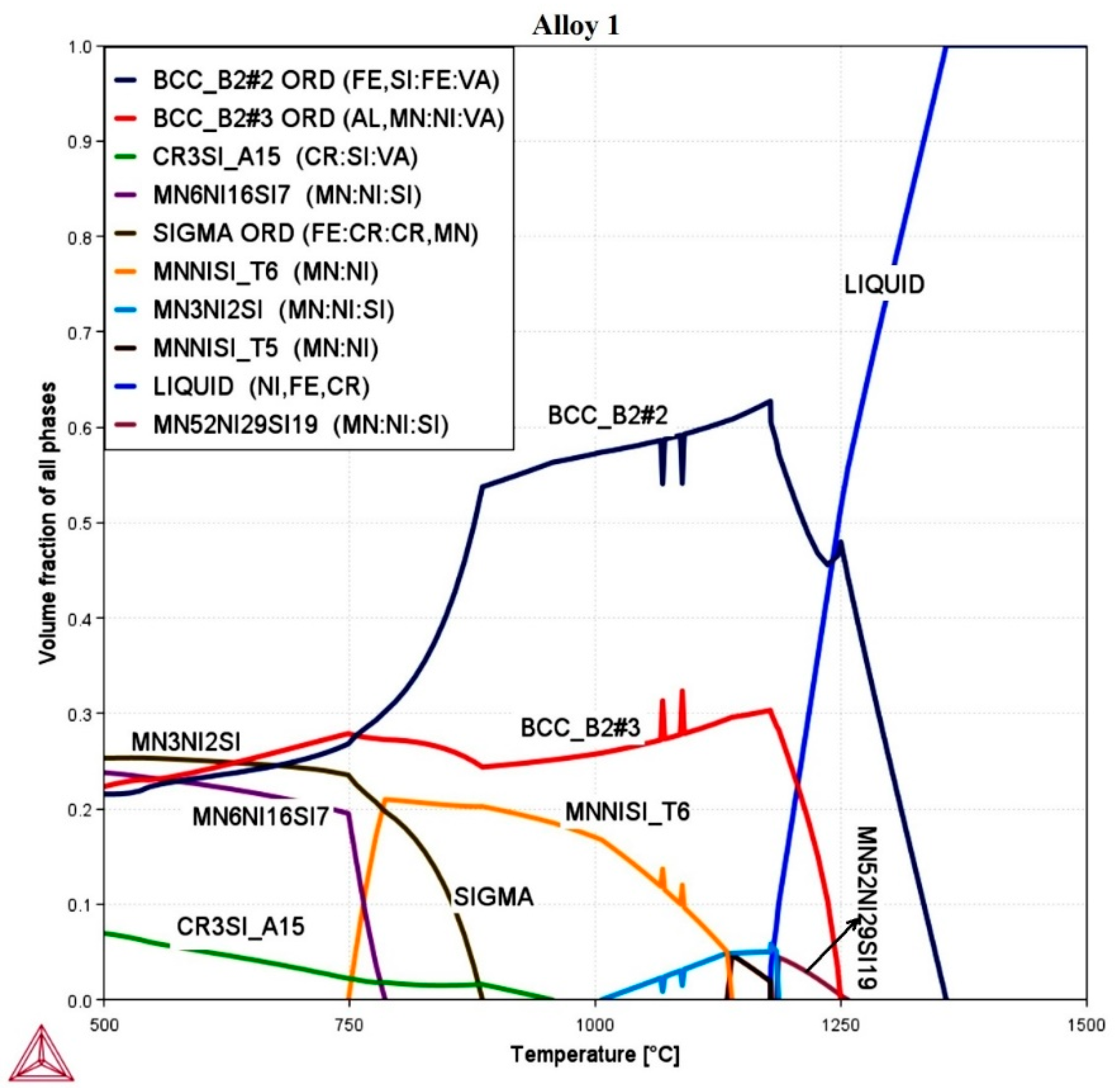


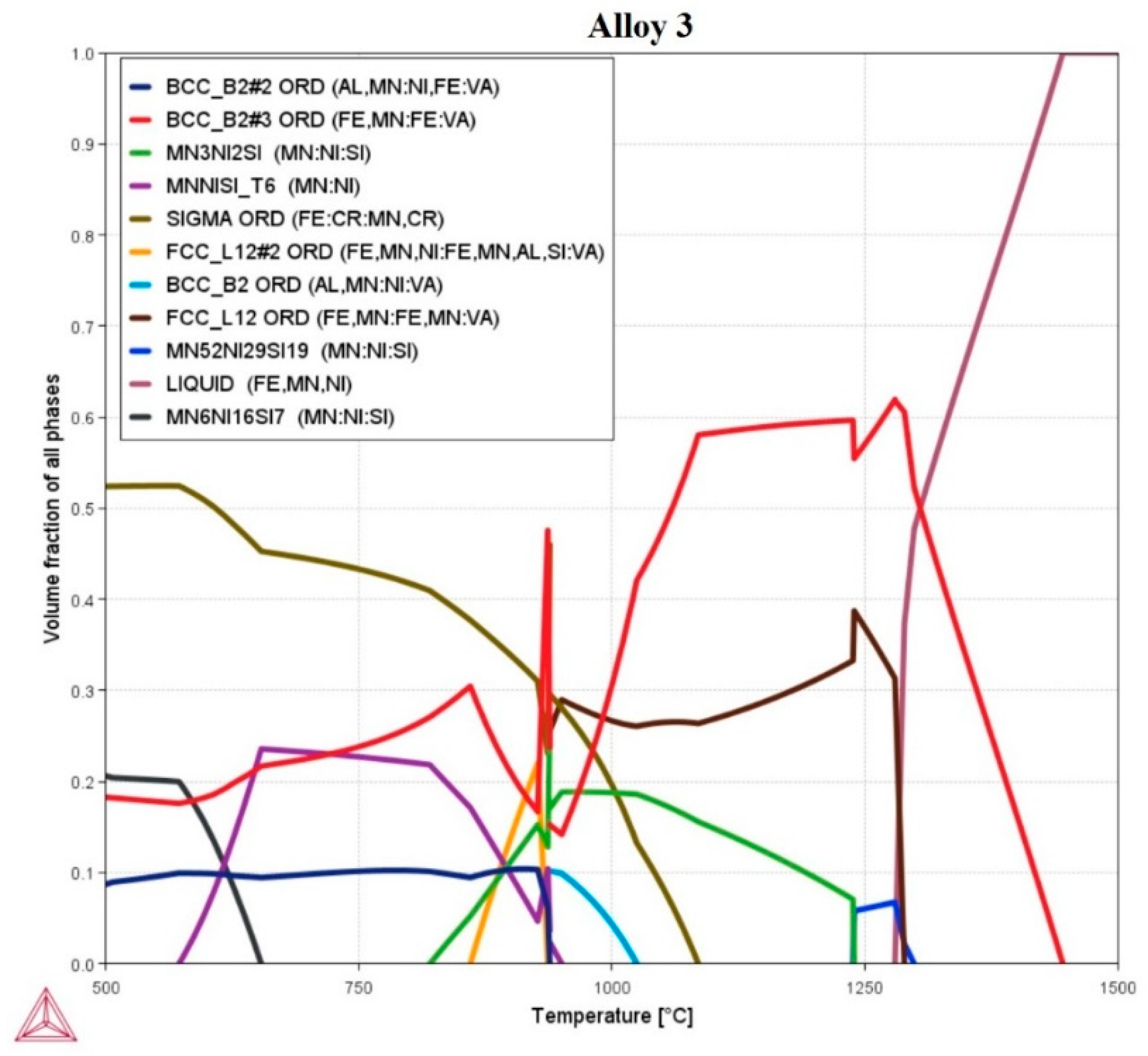
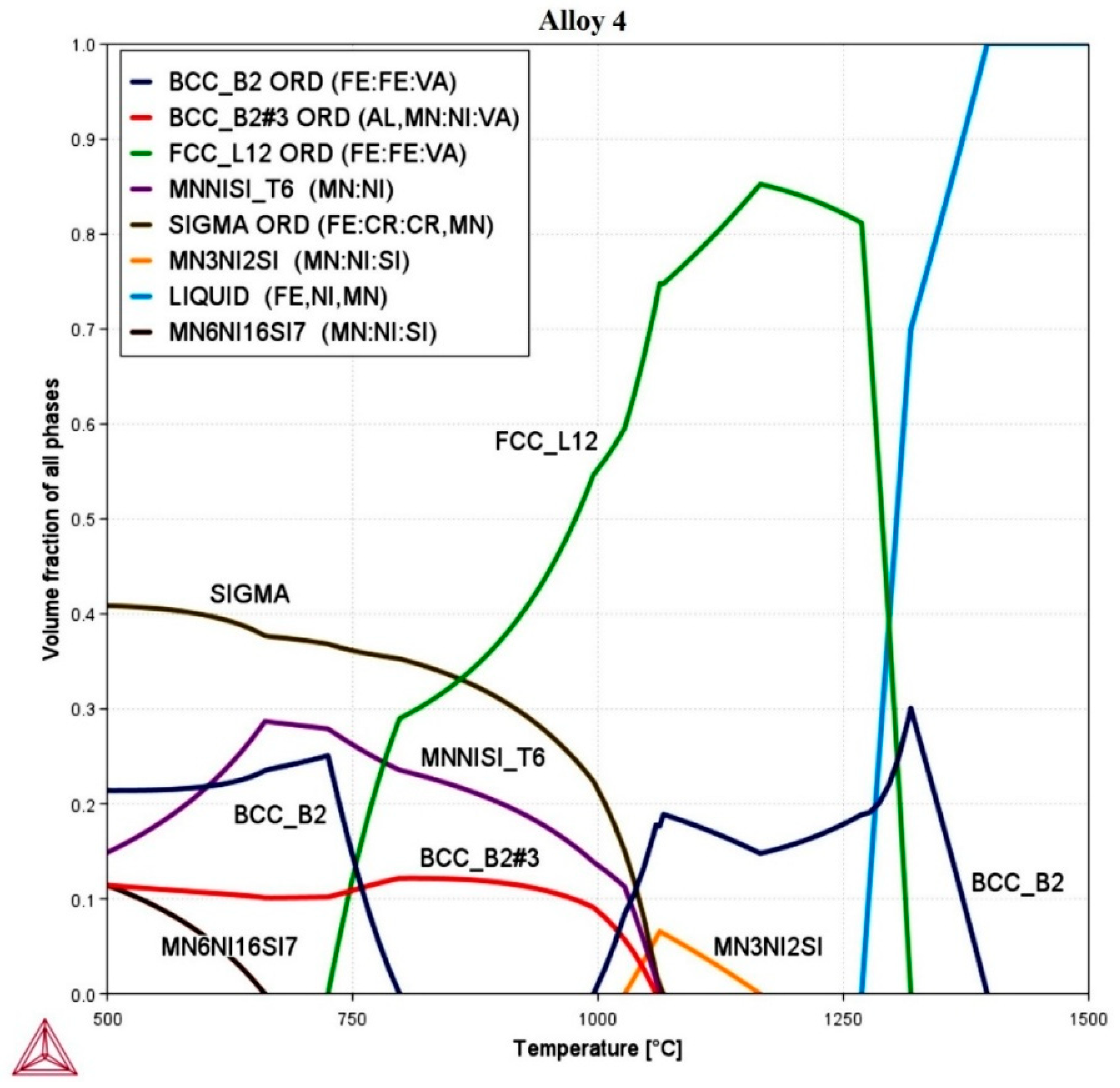
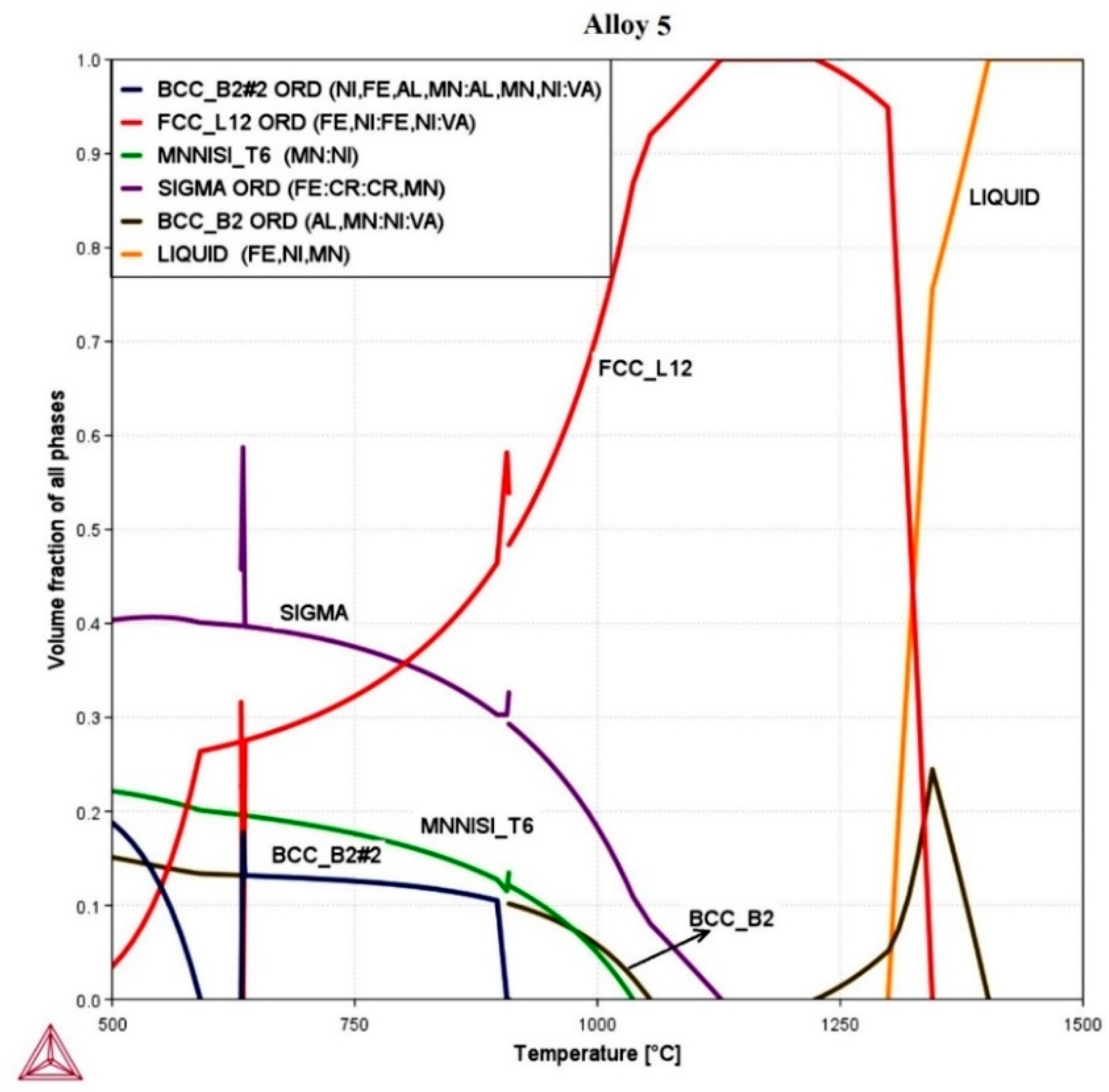
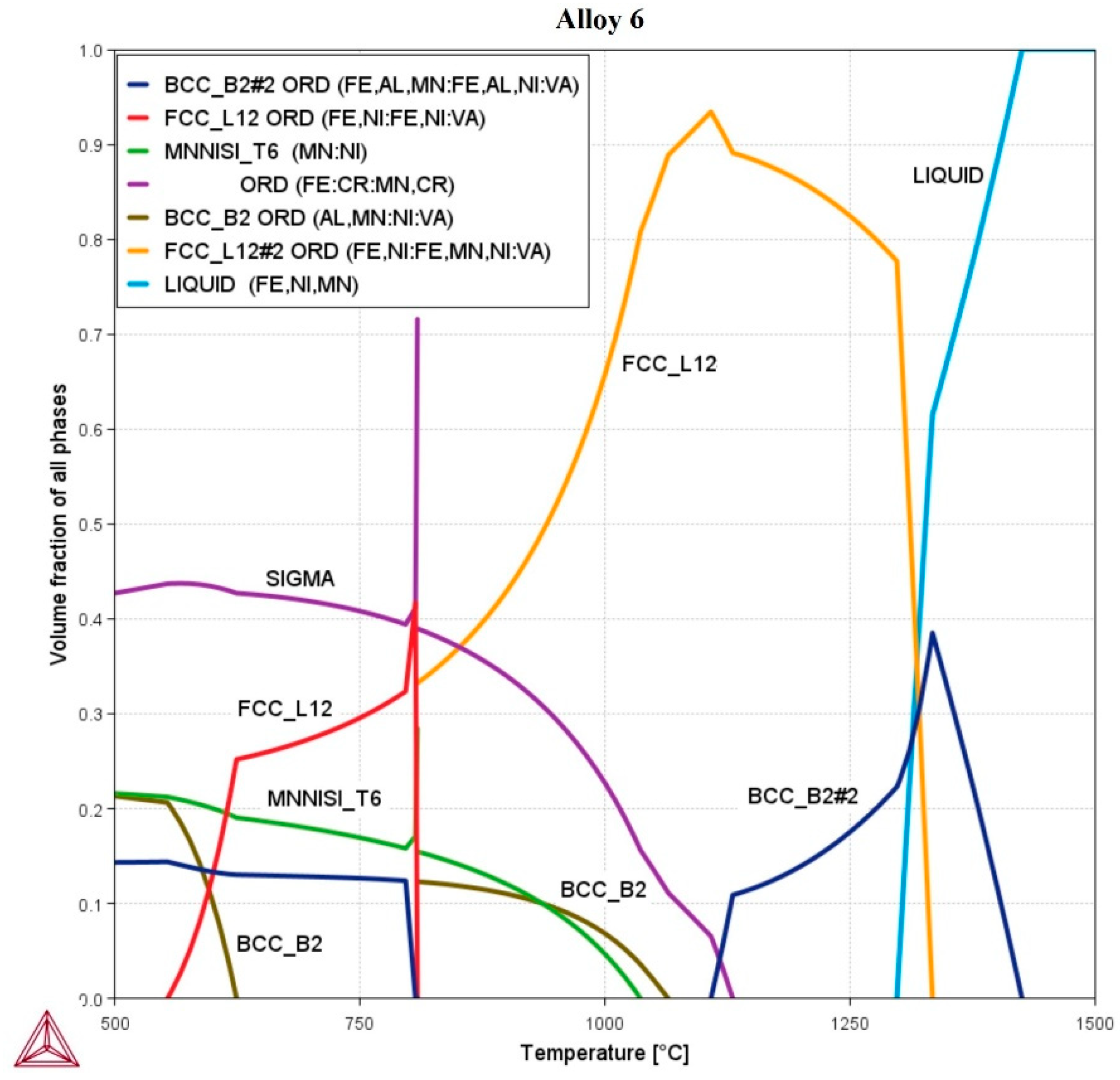
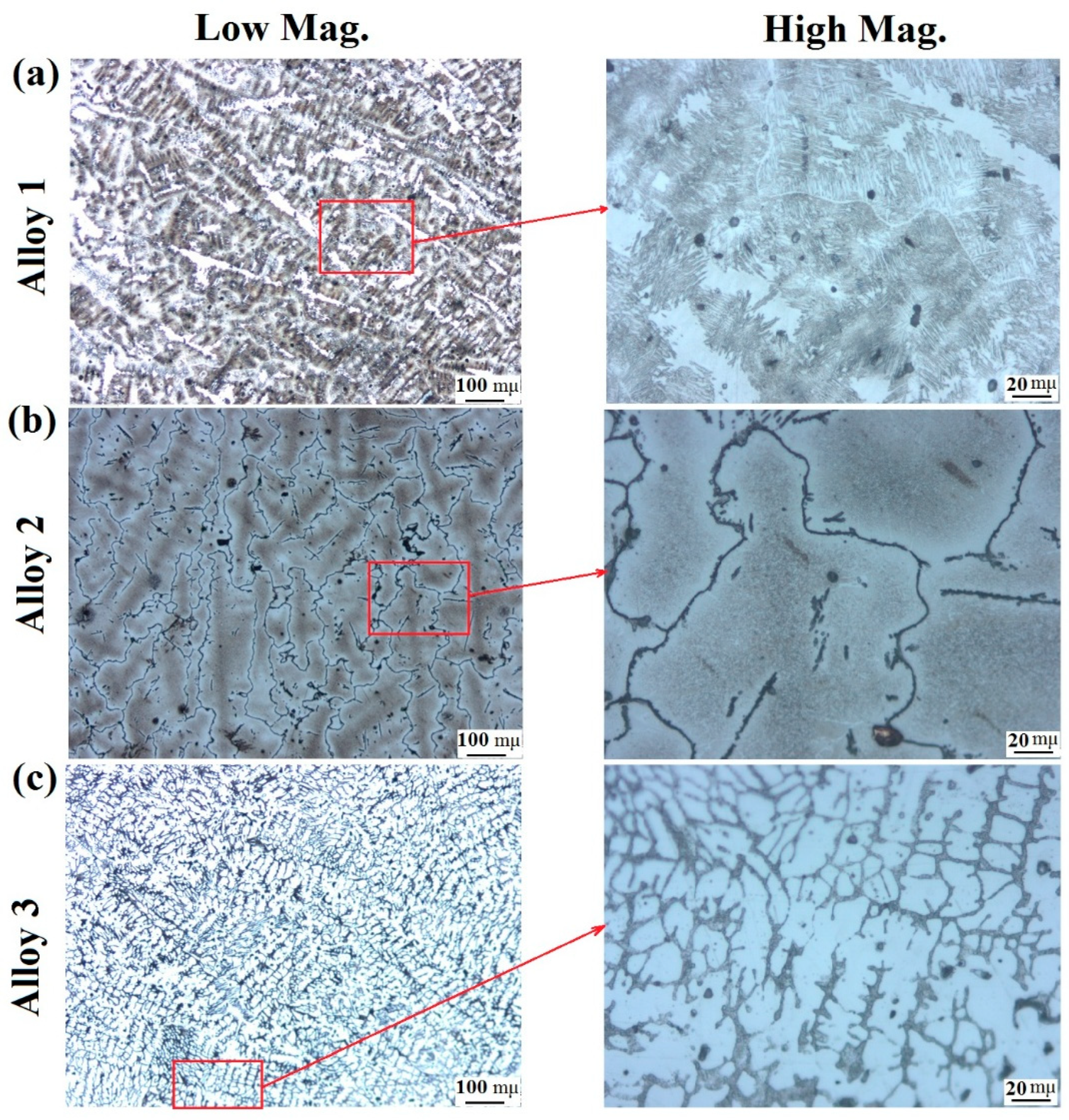
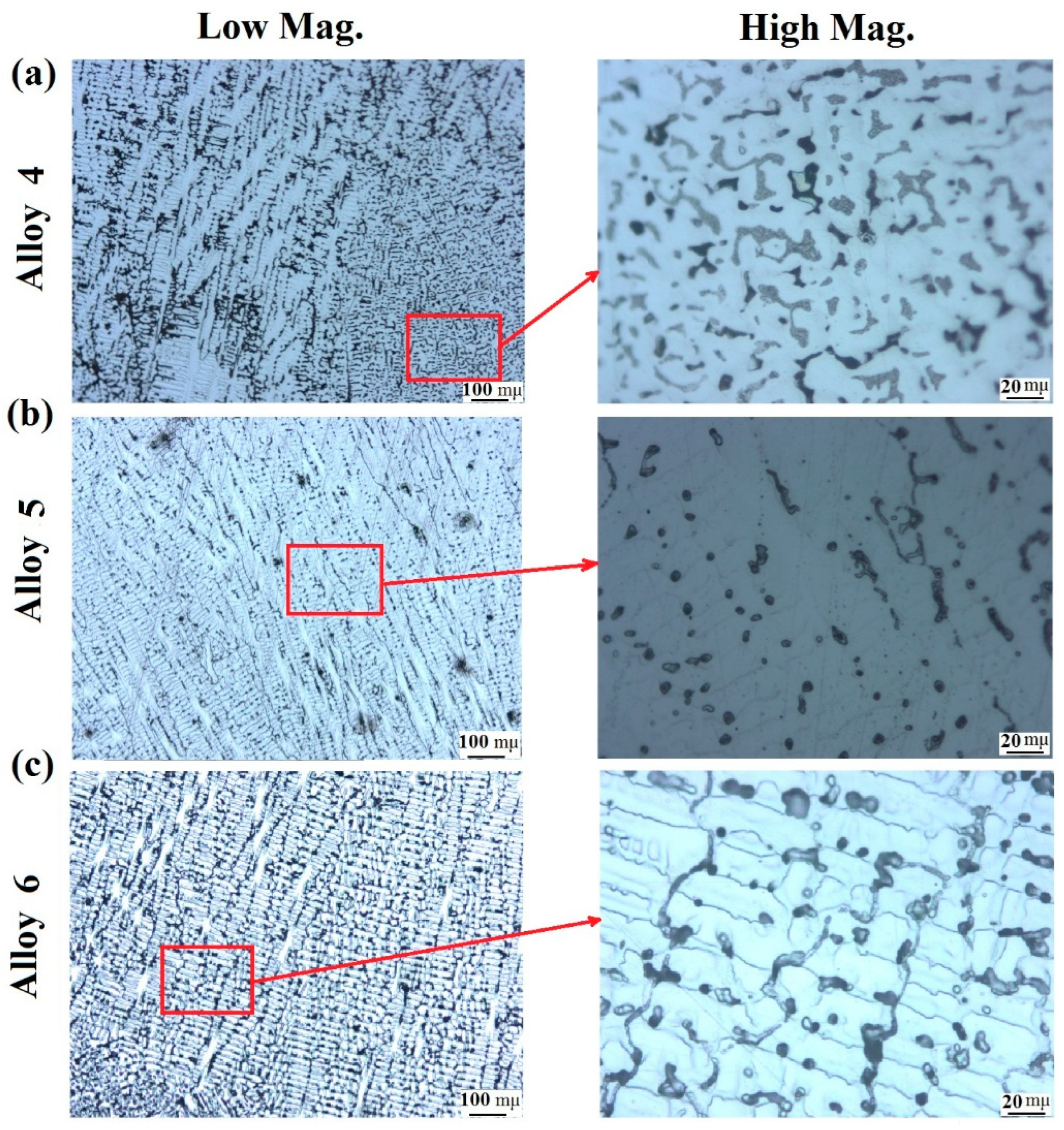
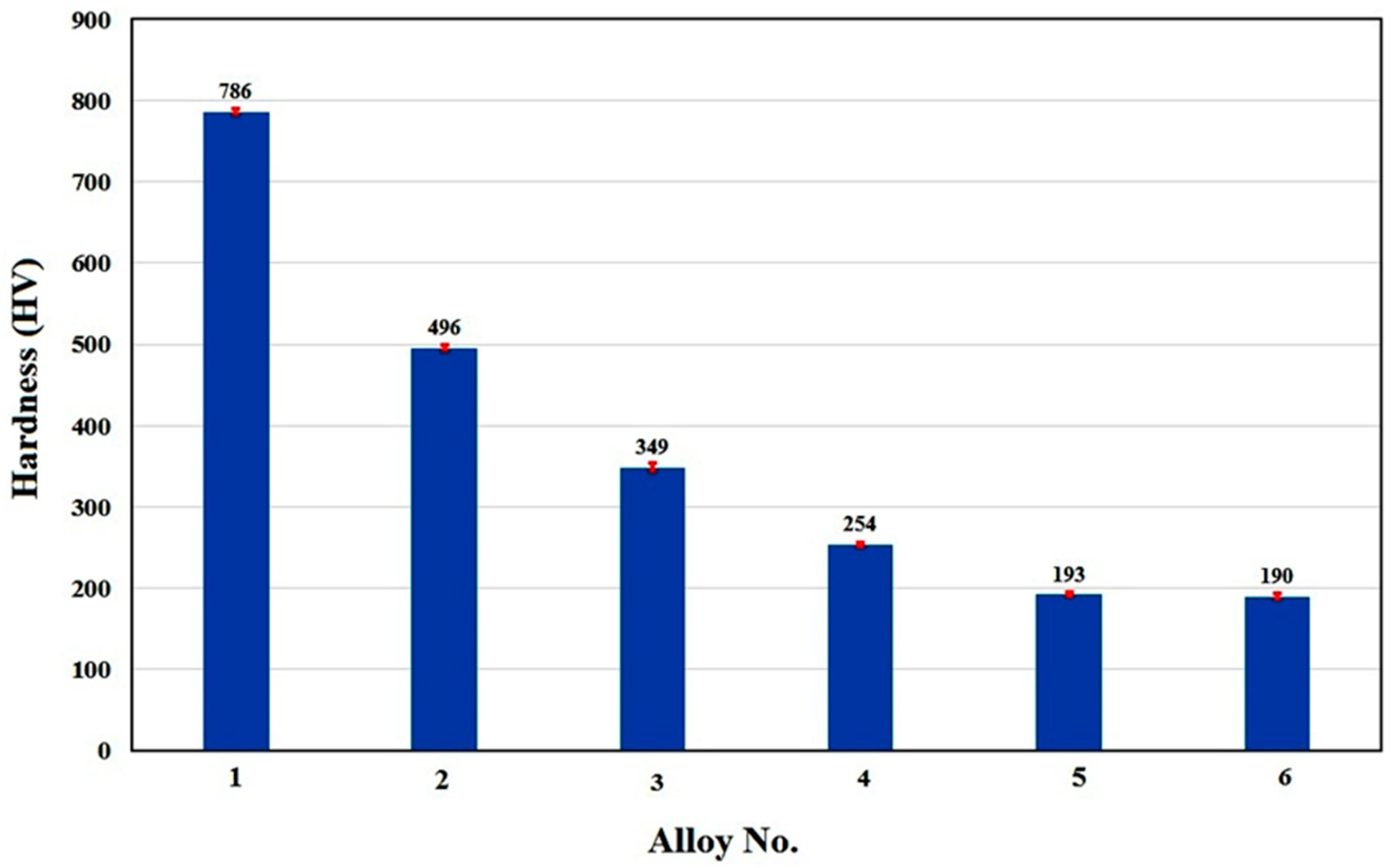
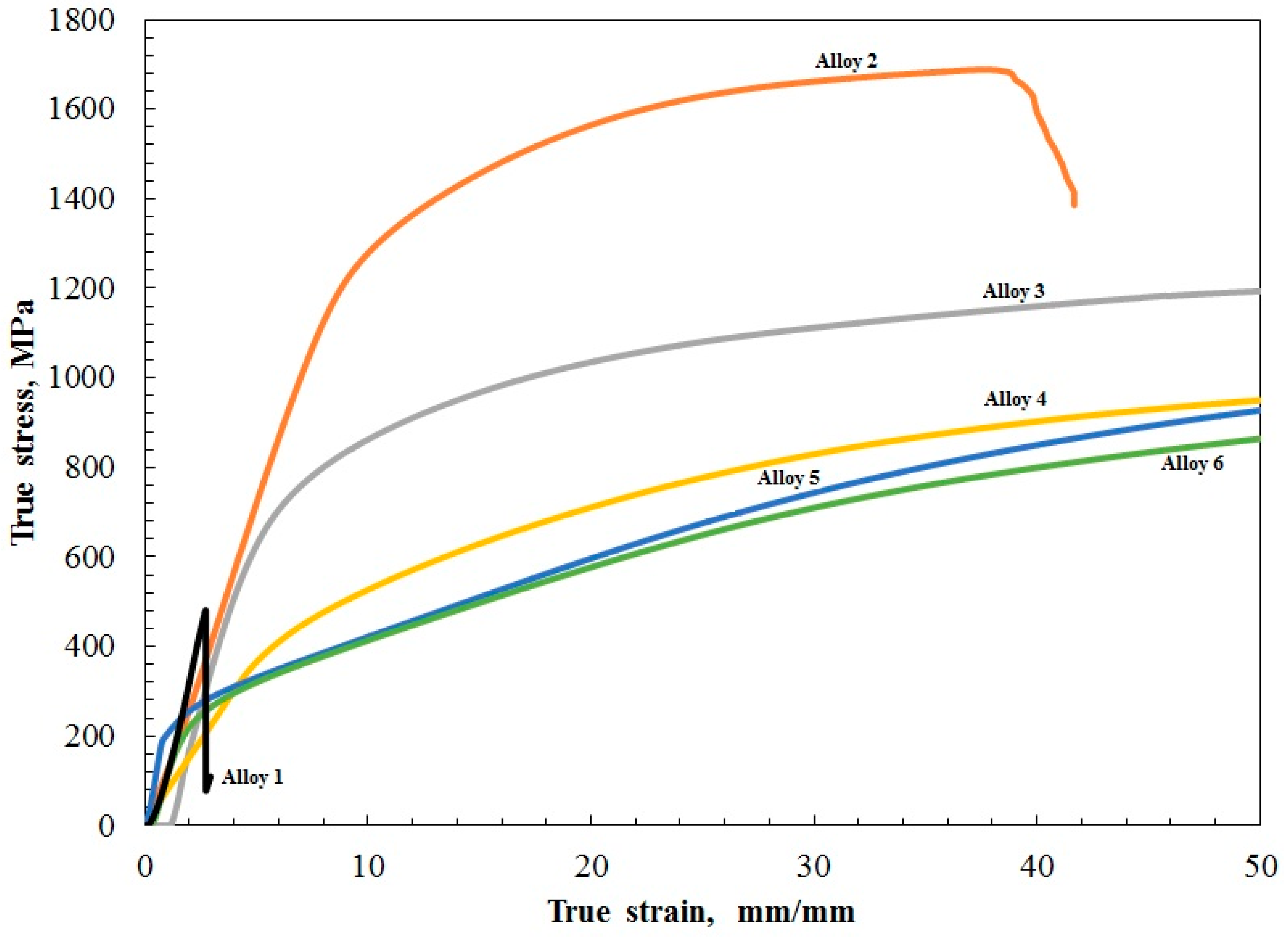
| Alloy | Fe | Mn | Ni | Cr | Al | Si |
|---|---|---|---|---|---|---|
| 1 | 30 | 15 | 20 | 15 | 10 | 10 |
| 2 | 35 | 15 | 20 | 15 | 10 | 5 |
| 3 | 35 | 25 | 15 | 15 | 5 | 5 |
| 4 | 35 | 20 | 20 | 15 | 5 | 5 |
| 5 | 35 | 20 | 22 | 15 | 5 | 3 |
| 6 | 36 | 20 | 20 | 16 | 5 | 3 |
Publisher’s Note: MDPI stays neutral with regard to jurisdictional claims in published maps and institutional affiliations. |
© 2022 by the authors. Licensee MDPI, Basel, Switzerland. This article is an open access article distributed under the terms and conditions of the Creative Commons Attribution (CC BY) license (https://creativecommons.org/licenses/by/4.0/).
Share and Cite
Mahmoud, E.R.I.; Shaharoun, A.; Gepreel, M.A.; Ebied, S. Phase Prediction, Microstructure and Mechanical Properties of Fe–Mn–Ni–Cr–Al–Si High Entropy Alloys. Metals 2022, 12, 1164. https://doi.org/10.3390/met12071164
Mahmoud ERI, Shaharoun A, Gepreel MA, Ebied S. Phase Prediction, Microstructure and Mechanical Properties of Fe–Mn–Ni–Cr–Al–Si High Entropy Alloys. Metals. 2022; 12(7):1164. https://doi.org/10.3390/met12071164
Chicago/Turabian StyleMahmoud, Essam R. I., Awaluddin Shaharoun, Mohamed A. Gepreel, and Saad Ebied. 2022. "Phase Prediction, Microstructure and Mechanical Properties of Fe–Mn–Ni–Cr–Al–Si High Entropy Alloys" Metals 12, no. 7: 1164. https://doi.org/10.3390/met12071164
APA StyleMahmoud, E. R. I., Shaharoun, A., Gepreel, M. A., & Ebied, S. (2022). Phase Prediction, Microstructure and Mechanical Properties of Fe–Mn–Ni–Cr–Al–Si High Entropy Alloys. Metals, 12(7), 1164. https://doi.org/10.3390/met12071164






